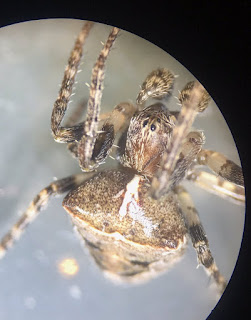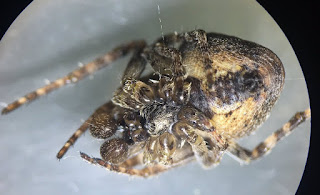Allow me to explain...
Christmas day 2016. The morning present opening was full steam ahead with Archie leading the way. I was sat, passing the boy his presents when something on one of the bags caught my eye; a Spider.
As is not unusual in our household, I shout Spider (or Fly, or Moth, or any insect for that matter!) and someone follows up with; "keep an eye on it, I'll get a pot!" Like a well oiled machine it is. Someone watching it, someone fetching a pot and someone helping to catch it.
I love Spiders. They're a group I enjoy observing and identifying and although I am FAR from being any sort of expert on them, I knew immediately that it was not something I recognised. That makes me excited. Not at all is the case that if I don't recognise it, it must be rare, but if I don't recognise it, it must be a new species for me - just as rewarding in my eyes.
After the un-wrapping and mandatory Dad jobs of installing batteries, putting together this-and-that and test driving everything in sight, I had a chance to take a look at our catch. I could tell right away that it was an Orb-weaver, one of the Araneidae family, the shape and general habitus gave that away. The abdominal markings led me to the genus 'Gibbaranea' which (thankfully) only leaves a handful of possibilities, four to be exact, with three of them described in M.J. Roberts' Spiders of Britain and Northern Europe.
Those being:
- G.gibbosa > similar markings but gibbosa having a green tint, sometimes quite striking.
- G.bituberculata > Once frequent at one site in Britain: Burnham Beeches (Bucks) before the bushes and plants supporting this species were cut to the ground, DESPITE the site being notified as an SSSI 3yrs earlier! Widespread in Northern Europe but generally uncommon.
- G.omoeda > Absent from britain. Widespread in Northern Europe.
Whilst comparing the Gibbaranea species, I just kept being drawn back to bituberculata. To confidently identify Spiders, you need to inspect the pedipalps (or 'palps') in adult males and the epigyne in adult females. In adult males, the palps are used as a reproductive organ, passing on the sperm. As such, the male palps are rather a complicated, intricate structure and individual to each species, hence, the part of the anatomy used to determine ID.
Almost as intricate as the parts themselves, are the drawings used to compare and clinch ID. Just take a look HERE at the species account for G.bituberculata to see what I mean.
Didn't take long to hit a speed bump when I got the spider under the microscope to find his palps were completely smooth. No structure or detail at all. I need to give a big thanks to MATT PRINCE now, for always helping me out with my spider troubles! He has taught me a lot and pointed out that 'my' spider is in fact a sub-adult, which is why the lack of fully formed palps. Matt told me that it looked to be only one moult away from full adulthood and so may be worth rearing it through - which is what I did! He went into a big pot with twigs, water and a few midges to feed on, and did pretty much nothing! Matt warned that they can be 'stubborn' and put off adulthood for months so I was prepared for the long haul.
Jan 18th - checked the pot and felt like it was Christmas again! No long haul for me, barely 3 weeks of waiting and there was a freshly moulted exoskeleton at the bottom of the pot, with a fresh, dapper looking male at the top, showing off his new suit! Thankfully, Matt's knowledge was bang-on and it was only the one moult needed. Cheers again Matt!
A look under the microscope and glance at a fully formed palps confirmed a full adult. Next came the hard, yet rewarding part: getting a confident ID. Was my initial thought a bit far fetched? Have I stumbled across a decent find? Well, no AND yes to those questions as it WAS
bituberculata! In my eyes, anyway. Only thing is, my eyes are not expert eyes so I needed confirmation which came by way of my Arachnid County Recorder; Pip Collyer.
Pip was quick on the case having us been liaising prior, regarding the find, and he was kindly confirmed it was bituberculata. Fantastic!
Finding a species not known in Britain for over 50yrs produces questions. In the back of my mind since the end of December was the fact that we had a real Christmas tree and more to the point, where would that have come from?
Like a snippet from a CSI programme, I turned my detective head on and went back to the garden centre we got our tree from to speak to the staff about the origins of our tree. They were surprisingly intrigued and very interested to hear of the spider themselves, and could not have been any more helpful.
Without the individual tree code (which we threw out straight away), it would be impossible to know the trees exact history. However, what they could tell me, was that this type and size of tree would've been grown in either Belgium OR Scotland. Great, I thought! Maybe there's an as yet, undiscovered population in Scotland somewhere now?! However, they then explained that whether grown in Belgium or Scotland, they would all have been shipped to the Netherlands, to then be shipped back to here in the UK (talk about carbon footprint!).
So, the exact origins are going to be left unknown. Could it have come from Scotland? Belgium? The Netherlands? Or did it just it jump on for somewhere to hide at the garden centre? Or even from my own garden where the tree layed for a few days before coming indoors? The last one's doubtful, but who knows?? Maybe one day it'll be the missing puzzle piece to a discovery in Scotland, or one closer to home? I shall be on the look out just in case!
Here are a few photos of the cracking Gibbaranea bituberculata:
These two are when he was sub-adult. Note the lack of any structure or detail to the palps, they are just smooth 'bulbs' (minus the hair of course).
 |
| Sub-adult |
 |
| Sub-adult |
Now compare to these next two. After moulting to emerge as a full adult:
See how complex the palps have now become?
 |
| adult |
 |
| adult |
Just a couple more of this great Spider:
 |
| Gibbaranea bituberculata |
 |
| Gibbaranea bituberculata |
 |
| Gibbaranea bituberculata |
No comments:
Post a Comment